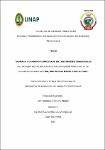Biomasa y carbono almacenado en las especies comerciales del bosque de colina baja de la concesión forestal N° 16-LOR-MAY/CON-MAD-2018-004, distrito de Mazán, Loreto. 2022
Abstract
The biomass and the carbon stored in commercial species of a low-hill forest in the district of Mazán, Loreto, Peru were quantified. Data from the forest census of the commercial species of the operational plan (PO)1 of the cutting plot (PC) 1 of the forest concession contract No. 16-LOR-MAY/CON-MAD-2018-004 for timber purposes was evaluated. The results show a total dry biomass of 41 011,92 kg/ha, where Parkia ulei contributes with the highest biomass of 4785,02 kg/ha and Diplotropis martiusii with 2485,50 kg/ha. The diameter class from 70 cm to 80 cm contains the higher amount of dry biomass of 11 511,07 kg/ha and from 60 cm to 70 cm of 10 079,08 kg/ha. The stored carbon is 20,51 tC/ha, where Parkia ulei contains the higher amount of 2,39 tC/ha and Diplotropis martiusii of 1,24 tC/ha. The diameter class from 70 cm to 80 cm contains 5,76 tC/ha of stored carbon of and from 60 cm to 70 cm contains 5,04 tC/ha. A significant statistical difference (α = 0,05) between the biomass and stored carbon averages was found. Se cuantificó la biomasa y el carbono almacenado en las especies comerciales de un bosque de colina baja del distrito de Mazán, Loreto, Perú. Se evaluó los datos del censo forestal de las especies comerciales del plan operativo (PO)1 de la parcela de corta (PC) 1 del contrato de concesión forestal N° 16-LOR-MAY/CON-MAD-2018-004 con fines maderables. Los resultados indican una biomasa seca total de 41 011,92 kg/ha, donde Parkia ulei aporta la mayor biomasa de 4785,02 kg/ha y Diplotropis martiusii de 2485,50 kg/ha. La clase diamétrica de 70 cm a 80 cm contiene mayor biomasa seca de 11 511,07 kg/ha y de 60 cm a 70 cm de 10 079,08 kg/ha. El carbono almacenado es de 20,51 tC/ha, donde Parkia ulei aporta mayor cantidad de 2,39 tC/ha y Diplotropis martiusii de 1,24 tC/ha. La clase diamétrica de 70 cm a 80 cm contiene mayor carbono almacenado de 5,76 tC/ha y de 60 cm a 70 cm de 5,04 tC/ha. Estadísticamente existe diferencia significativa (α = 0,05) entre los promedios de biomasa y carbono almacenado.
Collections
- Tesis [407]


